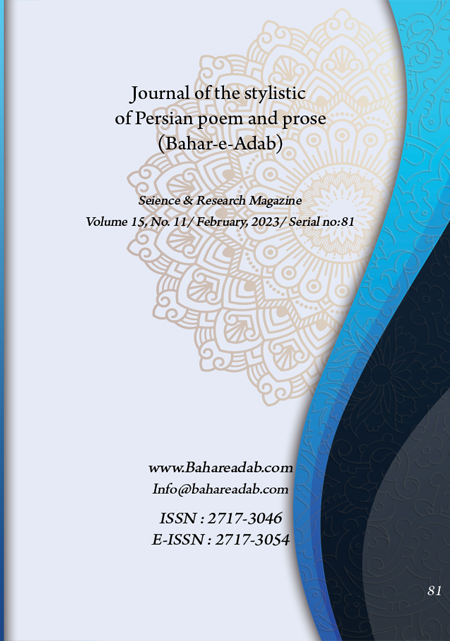- Count View : 301
- آدرس کوتاه شده مقاله: https://bahareadab.com/article_id/1406
- کد doi مقاله: Doi: 10.22034/bahareadab.2023 .15 .6743
Journal of the stylistic of Persian poem and prose
volume Number 15،
number In Volume 11،
،
issue Number 81
Innovations of simile in Khaghani's poems
Marzieh Rahmani , Hengameh Ashouri (Author in Charge), Sorayya Razeghi
Abstract
BACKGROUND AND OBJECTIVES: Simile is one of the prominent elements of imageries and its investigation has a significant effect on recognition of the poet"s style. This study deals with a linguistic-grammatical method i.e. Brook-Rose categorization method for deriving Khaghani"s similes in order to answer these questions: what are the prominent structural features of similes in Khaghani"s odes based on Brook-Rose categorization method? What fields are included in basic realms of vehicles in Khaghani"s odes?
METHODOLOGY: This study applied descriptive-analytic method.
FINDINGS: Upon using Brook-Rose quintet categorization method for Khaghani "s similes, the findings demonstrated that copula-attributive, genitive and pointing enjoy the highest frequencies respectively. Then, the genitive structure (concise simile) enjoys the highest frequency; Brook-Rose considers the usage of preposition "of" (an equivalent for "اِ" in Persian language) in Khaghani"s odes as a method for establishment of this relationship. Khaghani used some methods for creating novel, concise and prominent simile in many cases; then, the third most frequent method is pointing method. Allegory method enjoys the highest frequency among other methods. Attributive method has the lowest frequency by using verb "making" among Brook methods. The things realm is the widest realm of vehicles in Khaghani odes.
CONCLUSION: Regarding Brook-Rose categorization, Khaghani used simile in most verses for the praised, its appurtenants, and self respectively. The highest usage of attribute and transformation is for "The Praised"; then the poet"s "self" and his appurtenants are boldly present in the categorization.
Keyword
Khaghani
, Simile
, Brook-Rose
, Realm
, Odes
- Abu Deib, Kamal. (2005). Images of Imagination in Jorjani Theory, translated by Farzan Sojudi and Farhad Sasani, Tehran: Art Studies and Research.
- Aq Oli, Abdolhossein. (1961). Dar al-Adab in Fan Ma'ani, Tehran: Al-Hejra.
- Barzegar Khaleghi, Mohammad Reza. (2008). Description of Khaghani's Divan, Vol. 1, Tehran: Zavvar.
- Brook – Rose Christine. (1956). A grammar of metaphors, London, Mercury Books edition.
- Cuddon, J.A. (1999), A dictionary of literary Terms and theory – Harmonds worth, penguin books Ltd.
- Homayi, Jalaluddin. (1975). Rhetoric and Literary Crafts, Tehran: Iran Revolutionary Guards University.
- Kazazi, Mir Jalaluddin. (2013). Report on the Difficulties of Khaghani's Divan, Tehran: Markaz Publishing.
- Khaghani Shervani. (2014). Divan, edited by Mir Jalaluddin Kazazi, Tehran: Markaz Publishing.
- Ma'dankan, Masoumeh. (2008). Eastern Bridal Cup (description of 6 poems from Khaghani's Divan), Tehran: University Publishing Center.
- Mahozi, Amir Hossein. (2009). A Study of Simile in Shams Ghazals, Tehran: Islamic Azad University, Roodehen Branch.
- Mousavi, Mir Nematullah. (2003). Farhang Badiei, Tabriz: Ahrar.
- Pournamdarian, Taghi. (1995). Travel in May, Tehran: Zemestan.
- Radviani, Mohammad. (1949). translator of Balagha, by Ahmad Atash, Istanbul.
- Sakaki, Abu Ya'qub Yusuf ibn Muhammad. (1403 AH / 1983 AD). Muftah al-Uloom, by Naeem Zarzour, Beirut.
- Shamisa, Sirus. (2009). Poetry Stylistics, Tehran: Mitra.
- Shamisa, Sirus. (2011). Expression and Meanings, Tehran: Mitra.
- Shamisa, Sirus. (2014). Bayan, Tehran: Mitra.
- Taftazani, Massoud. (AH 1407). Sharh al-Mukhtasar, by the effort of Sharif, Qom.
- Volk René and Warren Austen. (2003). Literary Theory, translated by Zia Movahed and Parviz Mohajer, Tehran: Scientific and Cultural.

